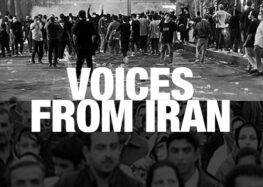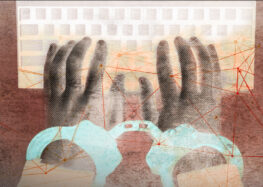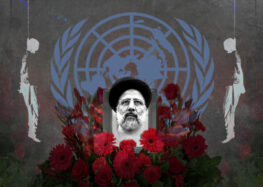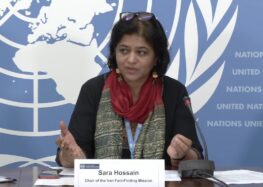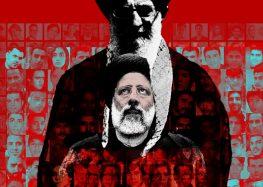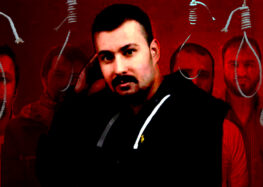UN Must End “Sterile Exchanges” and Investigate Iran’s Lethal Violence against Protesters, Says Father of Slain Demonstrator
Letter Reveals New Details: 144 Bodies Secretly Held in Karaj Medical Examiner’s Office Alone
June 29, 2020 — In an impassioned plea to top UN officials, the father of Pouya Bakhtiyari, who was one of hundreds of demonstrators shot and killed by Iranian security forces during the protests that swept through Iran in November 2019, called on the UN to end the “sterile exchanges” with the Iranian authorities and establish a Commission of Inquiry to investigate and document the government’s “lethal repression” against the protesters.
Pouya Bakhtiyari, 27, was shot in the head and killed on November 16, 2019, minutes after he joined a protest in the streets of Karaj, a city west of Tehran.
The indiscriminate firing of live ammunition by security forces at unarmed civilians was widely documented by citizen journalists and human rights organizations. Hundreds of protesters and bystanders, including women and children, were reliably reported to be killed. The authorities have provided no information on those killed nor has there been any independent investigation into the state’s actions.
In the letter, dated May 29, 2020, the grieving father, Manouchehr Bakhtiyari, describes the harrowing account that followed his son’s death. The letter details:
- The struggle to obtain son’s body from the hospital: “We had to defy Karaj’s Prosecution Office’s refusal to release Pouya’s body and allow a family burial. … this refusal was based on an instruction from the Ministry of Interior to carry off all the protesters killed in Karaj—144 bodies as I was told at Karaj’s Medical Examiner’s Office—and bury them in Tehran.”
- State-dictated burials and mourning: “We buried Pouya…under heavy security force supervision…[and] Pouya’s mother and I were summoned three times to the Bureau and the Prosecution Office and warned to cancel our public invitation to his 40th day memorial gathering at his grave.”
- Threats and summoning of family members: “Since [Pouya’s death] the Bureau of Inquiries, part of the Ministry of Intelligence and Security, has repeatedly threatened our family by telephone…I am frankly afraid that they may seek to silence us completely by any means possible.”
- House ransacked: On December 24, “more than fifty plainclothes officers raided our residence. They ransacked every room and seized all our photographs, letters, books, computers, and mobile phones.”
- Detainments, solitary confinements for family members: After parents insisted on inviting the public to their son’s 40th memorial ceremony, “The entire family, including myself, Pouya’s mother, sister, brother-in-law, two uncles, and an 11-year-old cousin were handcuffed, blindfolded, and taken in separate cars to Karaj’s Reja’i Shahr prison. We were isolated from each other and held for periods ranging from two days to a month.”
The letter notes that UN officials had urged the Iranian authorities to undertake an independent investigation but the response had been “flat rejections…unsubstantiated denials, untruths, and accusations of partiality and incompetence against the mechanisms.” The father stressed, “these sterile exchanges have generated no accountability or justice.”
Bakhtiyari continued: “I hope that the United Nations will now step beyond the current ‘dialogue’ which is, of course, not dialogue at all, and finally give voice to the victims. The pattern of violations in Iran is longstanding, widespread and severe and surely deserves a different form of international investigative mechanism, adequately equipped to collect and preserve evidence for future criminal proceedings.”
The letter, in its entirety, is reprinted below (click here for the PDF version).
To: Michelle Bachelet, UN High Commissioner for Human Rights,
Javaid Rehman, Special Rapporteur on the situation of human rights in the Islamic Republic of Iran,
Leigh Toomey, Vice-Chair of the Working Group on Arbitrary Detention,
Luciano Hazan, Chair-Rapporteur of the Working Group on Enforced or Involuntary Disappearances,
Agnes Callamard, Special Rapporteur on extrajudicial, summary or arbitrary executions,
David Kaye, Special Rapporteur on the promotion and protection of the right to freedom of opinion and expression,
Clement Nyaletsossi Voule, Special Rapporteur on the rights to freedom of peaceful assembly and of association,
Michel Forst, Special Rapporteur on the situation of human rights defenders,
Diego García-Sayán, Special Rapporteur on the independence of judges and lawyers,
Nils Melzer, Special Rapporteur on torture and other cruel, inhuman or degrading treatment or punishment.
RE: A plea from a victim’s bereaved father for stronger UN action with respect to Iranian government’s recent bloodiest crackdown on street protestors: Help shed light on the truth, give voice to the victims, and push for accountability for violations
I am writing to thank you, on behalf of my own bereaved family and the families of other victims, for turning your attention to the Islamic Republic of Iran’s lethal crackdown on the street protests in November 2019 and to request stronger action.
My own beloved son, Pouya Bakhtiyari, 27, was shot in the head and killed on the evening of 16 November 2019, just minutes after he had joined a protest in the streets of Karaj, a large city west of the capital, Tehran. We who are left behind feel bound in conscience to seek the whole truth about the circumstances of Pouya’s death, to make the facts known, and ensure the perpetrators are held accountable. Unfortunately, we are being subjected to bullying and intimidation by government’s intelligence and security forces, and by the judiciary, and I am frankly afraid that they may seek to silence us completely by any means possible.
After enduring a campaign of threats and reprisals by the government merely for speaking up and demanding justice for my son’s brutal killing, it was devastating for me to see that the government’s response to your expressions of concern and your inquiries has been a barrage of untruths, denials, and insults. The UN would be doing a great service to the victims and to their families who want to know the truth and see justice done if it were to move to establish a Commission of Inquiry, or similar mechanism, to investigate the killings and to preserve evidence with a view to future criminal proceedings against the perpetrators.
Pouya Bakhtiyari, an electronic engineer, managed our family business processing pistachios. He loved poetry and classical music and enjoyed an intense interest in the history of Iran and Persian calligraphy. His commitment to the environment had led him to become vegan. He was not politically involved in any formal way but he was a socially responsible young man, and it is clear, from video footage found on his phone, that he became aware of the protests while driving home from work. He joined the protests spontaneously later that evening with his mother and sister to express his frustration at the recent petrol price increases introduced by the Iranian government, the latest development following decades of chronic mismanagement, corruption and repression.
Pouya died in his mother’s arms on the way to hospital. A one-minute-long video that we managed to obtain at the hospital only from Pouya’s head shows at least one bullet wound. Immediately after Pouya had been pronounced dead, we had to defy Karaj’s Prosecution Office’’s refusal to release Pouya’s body and allow a family burial. According to Karaj’s deputy prosecutor, Ali Samadi, this refusal was based on an instruction from the Ministry of Interior to carry off all the protesters killed in Karaj—144 bodies as I was told at Karaj’s Medical Examiner’s Office—and bury them in Tehran. The hospital authorities had received instructions to issue burial permits worded in such a way as to hide the true cause of death. It was only after prolonged wrangling that they agreed to transfer Pouya’s body to the Medical Examiner’s Office. The next day, even though the entry for ‘reason of death’ in Pouya burial permit was changed from ‘blunt trauma’ to ‘crushed skull/bullet injury,’ we were refused any information about whether or not an actual autopsy had taken place. Finally, after two days of struggle we buried Pouya on 19 November in Karaj’s Behesht-e Sakineh Cemetery under heavy security force supervision.
Since then the Bureau of Inquiries, part of the Ministry of Intelligence and Security, has repeatedly threatened our family by telephone, and by summoning family members for questioning. The 40th day after the death of a loved one is an important day in Iranian mourning rites. Pouya’s mother and I were summoned three times to the Bureau and the Prosecution Office and warned to cancel our public invitation to his 40th day memorial gathering at his grave at Behesht-e Sakineh Cemetery. At 1:00 am of 24 December, just two days before the ceremony, more than fifty plainclothes officers raided our residence. They ransacked every room and seized all our photographs, letters, books, computers, and mobile phones. The entire family, including myself, Pouya’s mother, sister, brother-in-law, two uncles, and an 11-year-old cousin were handcuffed, blindfolded, and taken in separate cars to Karaj’s Reja’i Shahr prison. We were isolated from each other and held for periods ranging from two days to a month. I have given an account of my own month-long solitary confinement and temporary release pending trial on ‘national security’ charges in a separate submission to the UN Working Group on Arbitrary Detention.
Under the Iranian Criminal Procedure Code, the local prosecution office is responsible for investigating deaths from gunshots, and autopsy findings, including ballistics studies, are of course critically important in establishing the circumstances of any death by shooting. Karaj Prosecution Office acted in direct contravention of its duty under law by ensuring that no actual autopsy was carried out. Video footage of security forces firing at the heads and vital organs of unarmed protesters is now widely available on the internet for the whole world to see. The authenticity of the footage has not been challenged. Yet government authorities have provided no information on any investigations into the deaths of any of the other protestors. Nor have they given any official figure for the number killed, despite dismissing casualty figures reported by other sources. These include those reported as ‘at least 304’ by Amnesty International and ‘about 1,500’ reportedly provided by three unnamed Interior Ministry officials to Reuters.
Since the killings, the UN High Commissioner for Human Rights and the Special Procedures mandate holders to whom this letter is addressed repeatedly voiced their deep concern to the government of the Islamic Republic of Iran, and strongly urged the government to undertake prompt, independent and impartial investigations into all of the violations that took place in the context of the lethal suppression of the protest. This call was last reiterated on 6 March 2020 at the 43rd session of the Human Rights Council by Mr. Javaid Rehman, Special Rapporteur on the situation of Human Rights in the Islamic Republic of Iran.
Communications sent to the government of Iran quote an as yet unofficial figure of at least 304 deaths, including 12 children, and present substantial evidence of the excessive and unlawful use of lethal force by security forces. The UN Special Procedures mandate holders have asked the government of Iran to provide information on the number of deaths and injuries caused by excessive force used by security forces during the protests, as well as the results of any investigation and judicial or other inquiry undertaken, including autopsy reports for the alleged victims of arbitrary killings.
The Iranian authorities’ reaction has come in the form of two documents issued by the Judiciary’s ‘High Council for Human Rights’. These are presented as ‘responses’ to the UN bodies’ concerns and inquiries, but in fact they consist merely of flat rejections of the substantial body of evidence that violations did take place (including the video footage of shootings mentioned above), blanket denials that there was any wrongdoing on the part of security forces, and unsubstantiated accusations against the protestors, including the allegation, highly implausible under the circumstances, that some protestors were armed with ‘grenades,’ ‘incendiary gels,’ and ‘machine guns.’ Instead of answering the UN’s questions and providing the information requested, the Judiciary’s statements accuse UN officials and experts of political bias, abuse of their position, ignorance of human rights concepts, and acting as puppets of the United States, some European governments and their ‘regional slaves.’
I know that the Islamic Republic of Iran’s sad history of human rights violations has been condemned in many resolutions by the UN Human Rights Council and the General Assembly. I also know that those resolutions have been routinely rejected by the government of Iran. I see that legitimate enquiries made by the Special Procedures mandate holders with respect to these violations have been, more often than not, simply ignored. Where there has been a response, it has consisted of unsubstantiated denials, untruths, and accusations of partiality and incompetence against the mechanisms. Another recent example is the Judiciary’s 5 January 2018 response to the Special Procedures experts’ concerns and enquiries with respect to the government’s December 2017 bloody crackdown on protests, in which at least 21 deaths were confirmed by official news channels. It is a matter for great regret that these sterile exchanges have generated no accountability or justice in respect of any of those violations, and that the government meanwhile has continued its violations under cover of diplomatic back-and-forth and ‘dialogue’.
As a bereaved father of one of the protesters who was brutally killed in those days, I lost all faith in the domestic legal machinery when I was obliged to bury my son under the gaze of security forces after the prosecution office had blocked the autopsy, so that I did not even know if the bullet or bullets that killed him were still lodged in his body. As a result of my loss, I now directly share the pain and frustration of the relatives of all those whose loved ones have been arbitrarily killed, imprisoned, tortured, abused and discriminated against by the government over the past 41 years, and share too their longing for truth and justice. I hope that the United Nations will now step beyond the current ‘dialogue’ which is, of course, not dialogue at all, and finally give voice to the victims. The pattern of violations in Iran is longstanding, widespread and severe and surely deserves a different form of international investigative mechanism, adequately equipped to collect and preserve evidence for future criminal proceedings.
A significant first step could be the setting up of a Commission of Inquiry, or similar mechanism, to investigate, as comprehensively as possible, and to document and report the government of Iran’s lethal repression of protests in November 2019, the bloodiest in the government’s 41-year history, and to preserve the evidence for future criminal proceedings. I stand ready to assist and cooperate with such mechanism in any way I can, regardless of any retaliatory consequences that I may face from the government of the Islamic Republic of Iran.
I, therefore, urge you to support the establishment of such a mechanism for Iran, including raising it, as a matter of urgency, in the upcoming 44th Session of the United Nations Human Rights Council, which will take place from 15 June to 3 July 2020.

Yours respectfully,
Manouchehr Bakhtiyari
29 May 2020
References:
UN High Commissioner for Human Rights, statement of 6 December 2019.
UN Special Procedures mandate holders, communications of 20 November and 18 December 2019).
The Islamic Republic of Iran’s High Council for Human Rights, statement of 5 December 2019 and communication of 18 February 2020 and 5 January 2018.
Amnesty International, 16 December 2019 and 20 May 2020.
Reuters, 23 December 2019 .
Video of Pouya Bakhtiyari’s lethal bullet wound to the head taken at hospital.
Read this article in Persian.


